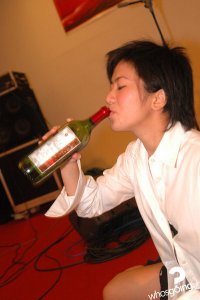Grapes grow in different ways depending on what soils and climates they grow in. And in the last few years, a number of California winery owners have expressed irritation that their growing regions’ wines aren’t as highly rated as are wines of other, warmer areas.
Many of the growers who seek a better public image say they are in cooler climates, and their wines are not as full-bodied and as rich, and thus not as acclaimed, as are wines from warmer areas.
This is a generalization, of course, that ignores the fact that great rieslings, pinot noirs and chardonnays usually are made in areas that are cool. But for most other grapes, such as syrah, zinfandel, cabernet sauvignon, merlot, sangiovese and petite syrah, warmer climes produce flavors that seem to be more respected and in demand these days, especially with those who rank wines by putting scores on them.
When grapes grow in a hot climate in which the nighttime temperatures stay pretty warm as well, sugar develops in the fruit faster than the ripe-fruit flavor does. So, for instance, in the hot central San Joaquin Valley, it’s pretty hard to make a “great” wine because flavors tend to be rather simple.
Some grapes are simply in need of warm, but not hot, areas. For instance, you find very little cabernet sauvignon planted in truly cold climates, such as in the western Russian River of Sonoma County. There, pinot noir is the lead grape.
Cabernet can make an elegant wine near the Russian River, but big and bold is what’s in vogue, and you simply can’t make that sort of cabernet in such a cold area. Napa Valley is warm enough to grow cabernet to perfection, but cool enough to keep the balance of the wine appropriate.
And in France’s Burgundy district, where cool-loving pinot noir flourishes, cabernet is outlawed.
So it was fascinating for me recently when I traveled two hours from Melbourne to the verdant Yarra Valley to visit De Bortoli winery and to ask how a winery can survive with cabernet and syrah (shiraz) in a world in which warm climates seem to be in the driver’s seat.
De Bortoli is one of the Yarra’s largest producers. It has 480 acres of prime land, having just acquired 80 acres from a neighbor that was planted largely to cabernet. Yet Yarra is chardonnay and pinot noir country.
And tasting through the latest De Bortoli wines, including the stylish 2007 chardonnay ($25) and 2007 pinot noir ($30), both of which won’t be released until October, I found that these are clearly made to reflect the cooler nature of the region.
Both wines are more delicate and refined than are warmer-climate brethren. And a 2005 cabernet sauvignon ($30) is also delicate and restrained.
Winemakers David Slingsby-Smith and Sarah Fagan revel in the delicacy derby. They say the winery operated by head winemaker Steve Webber is favored by those who love the more European, structured style of wines.
Then I tasted an as-yet unreleased 2007 shiraz ($30), and found it to be distinctively flavored with black pepper and herbs, racy black cherry fruit. It is a wine to serve with food. It demands food.
Fagan then noted that Yarra Valley shiraz will hardly ever make a fat, unctuous shiraz. This is almost exactly what writer Max Allen wrote in his 1999 Yarra Valley wine guide book:
“Yarra Valley shiraz will probably never be able to match McLaren Vale or the Barossa in the oomph stakes — but the argument for it is stronger than that against.”
I love cooler-climate red wines when they are made with balance, and I always find pleasure in the modest yet still distinctive De Bortoli wines.
Fortunately, such wines have other followers too, few though they may be. As much as I like full-flavored red wines, I see the absolute need for the wines of restraint and delicacy that De Bortoli does so well.
Wine of the Week: 2007 Craggy Range Sauvignon Blanc, Martinborough, Te Muna Road ($25). This dramatic white wine has the lime/lemon/grapefruit aroma we associate with New Zealand sauvignon blanc. But this wine is from the North Island and has a lot more restraint that do most of the Marlborough SBs from the northern tip of the South Island. This wine has great structure for aging, but it’s superb now with seafood and Thai dishes.
Dan Berger
skip to main |
skip to sidebar




Enhance the pleasure that you get from wine by sharing your experiences, knowledge, news articles and facts about the elixir of the gods and bacchanalia on earth by emailing: bacchusforyou@bellsouth.net

ORIGINAL BACCHANALIAN CREATION

BACCHANALIAN WINE GLASS

I LOVE WINE, BUT I NEED TO LEARN HOW TO DRINK IT

Related Links
Blog Archive
-
▼
2008
(305)
-
▼
August
(19)
-
▼
Aug 24
(14)
- Trimbach to produce a Grand Cru
- Winery wins fight to stop trees
- Wine Spectator Gives ‘Award of Excellence’ to Fake...
- The Wine Industry's Best Green Shipper Available I...
- ReCORK America gains recycling partner
- Bargain Barrels for '08 Vintage?
- Tasting Notes
- Cool climate wines
- Australia becomes New Zealand's biggest market
- The Sipping News
- Carmen Wines Go Green with Lighter Wine Bottles
- Olympics may help Dragon's Hollow, but importer sa...
- Reconsidering sulfites
- More California farmworkers dying from heat
-
▼
Aug 24
(14)
-
▼
August
(19)
How Much Did The Best Bottle of Wine You Ever Drank Cost?
CONTACT INFORMATION
TO SUBMIT A POST, TO BE PUT ON THE MAILING LIST, TO HAVE QUESTIONS ANSWERED, ETC.
EMAIL: